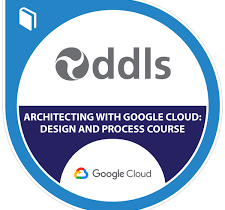Upgrade & Secure Your Future with DevOps, SRE, DevSecOps, MLOps!
We spend hours on Instagram and YouTube and waste money on coffee and fast food, but won’t spend 30 minutes a day learning skills to boost our careers.
Master in DevOps, SRE, DevSecOps & MLOps!
Learn from Guru Rajesh Kumar and double your salary in just one year.
Source:-https://google.qwiklabs.com
This course features a combination of lectures, design activities, and hands-on labs to show you how to use proven design patterns on Google Cloud to build highly reliable and efficient solutions and operate deployments that are highly available and cost-effective. This course was created for those who have already completed the Architecting with Google Compute Engine or Architecting with Google Kubernetes Engine course.
Prerequisites:
To get the most out of this course, participants should: ●Have completed Architecting with Google Compute Engine, Architecting with Google Kubernetes Engine, or have equivalent experience ●Have basic proficiency with command-line tools ●Have systems operations experience, including deploying and managing applications, either on-premises or in a public cloud environment
Objectives:
●Apply a tool set of questions, techniques and design considerations ●Define application requirements and express them objectively as KPIs, SLO’s and SLI’s ●Decompose application requirements to find the right microservice boundaries ●Leverage Google Cloud developer tools to set up modern, automated deployment pipelines ●Choose the appropriate Google Cloud Storage services based on application requirements ●Architect cloud and hybrid networks ●Implement reliable, scalable, resilient applications balancing key performance metrics with cost ●Choose the right Google Cloud deployment services for your applications ●Secure cloud applications, data and infrastructure ●Monitor service level objectives and costs using Stackdriver tools
Audience:
●Cloud Solutions Architects, Site Reliability Engineers, Systems Operations professionals, DevOps Engineers, IT managers. ●Individuals using Google Cloud Platform to create new solutions or to integrate existing systems, application environments, and infrastructure with the Google Cloud Platform.
Course Outline
The course includes presentations, demonstrations, and hands-on labs.
Module 1: Defining the Service
Describe users in terms of roles and personas.
Write qualitative requirements with user stories.
Write quantitative requirements using key performance indicators (KPIs).
Evaluate KPIs using SLOs and SLIs.
Determine the quality of application requirements using SMART criteria.
Module 2: Microservice Design and Architecture
Decompose monolithic applications into microservices.
Recognize appropriate microservice boundaries.
Architect stateful and stateless services to optimize scalability and reliability.
Implement services using 12-factor best practices.
Build loosely coupled services by implementing a well-designed REST architecture.
Design consistent, standard RESTful service APIs.
Module 3: DevOps Automation
Automate service deployment using CI/CD pipelines.
Leverage Cloud Source Repositories for source and version control.
Automate builds with Cloud Build and build triggers.
Manage container images with Google Container Registry.
Create infrastructure with code using Deployment Manager and Terraform.
Module 4: Choosing Storage Solutions
Choose the appropriate Google Cloud data storage service based on use case, durability, availability, scalability and cost.
Store binary data with Cloud Storage.
Store relational data using Cloud SQL and Spanner.
Store NoSQL data using Firestore and Cloud Bigtable.
Cache data for fast access using Memorystore.
Build a data warehouse using BigQuery.
Module 5: Google Cloud and Hybrid Network Architecture
Design VPC networks to optimize for cost, security, and performance.
Configure global and regional load balancers to provide access to services.
Leverage Cloud CDN to provide lower latency and decrease network egress.
Evaluate network architecture using the Cloud Network Intelligence Center.
Connect networks using peering and VPNs.
Create hybrid networks between Google Cloud and on-premises data centers using Cloud Interconnect.
Module 6: Deploying Applications to Google Cloud
Choose the appropriate Google Cloud deployment service for your applications.
Configure scalable, resilient infrastructure using Instance Templates and Groups.
Orchestrate microservice deployments using Kubernetes and GKE.
Leverage App Engine for a completely automated platform as a service (PaaS).
Create serverless applications using Cloud Functions.
Module 7: Designing Reliable Systems
Design services to meet requirements for availability, durability, and scalability.
Implement fault-tolerant systems by avoiding single points of failure, correlated failures, and cascading failures.
Avoid overload failures with the circuit breaker and truncated exponential backoff design patterns.
Design resilient data storage with lazy deletion.
Analyze disaster scenarios and plan for disaster recovery using cost/risk analysis.
Module 8: Security
Design secure systems using best practices like separation of concerns, principle of least privilege, and regular audits.
Leverage Cloud Security Command Center to help identify vulnerabilities.
Simplify cloud governance using organizational policies and folders.
Secure people using IAM roles, Identity-Aware Proxy, and Identity Platform.
Manage the access and authorization of resources by machines and processes using service accounts.
Secure networks with private IPs, firewalls, and Private Google Access.
Mitigate DDoS attacks by leveraging Cloud DNS and Cloud Armor.
Module 9: Maintenance and Monitoring
Manage new service versions using rolling updates, blue/green deployments, and canary releases.
Forecast, monitor, and optimize service cost using the Google Cloud pricing calculator and billing reports and by analyzing billing data.
Observe whether your services are meeting their SLOs using Cloud Monitoring and Dashboards.
Use Uptime Checks to determine service availability.
Respond to service outages using Cloud Monitoring Alerts.

 Starting: 1st of Every Month
Starting: 1st of Every Month  +91 8409492687 |
+91 8409492687 |  Contact@DevOpsSchool.com
Contact@DevOpsSchool.com